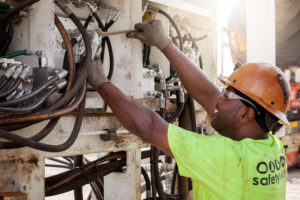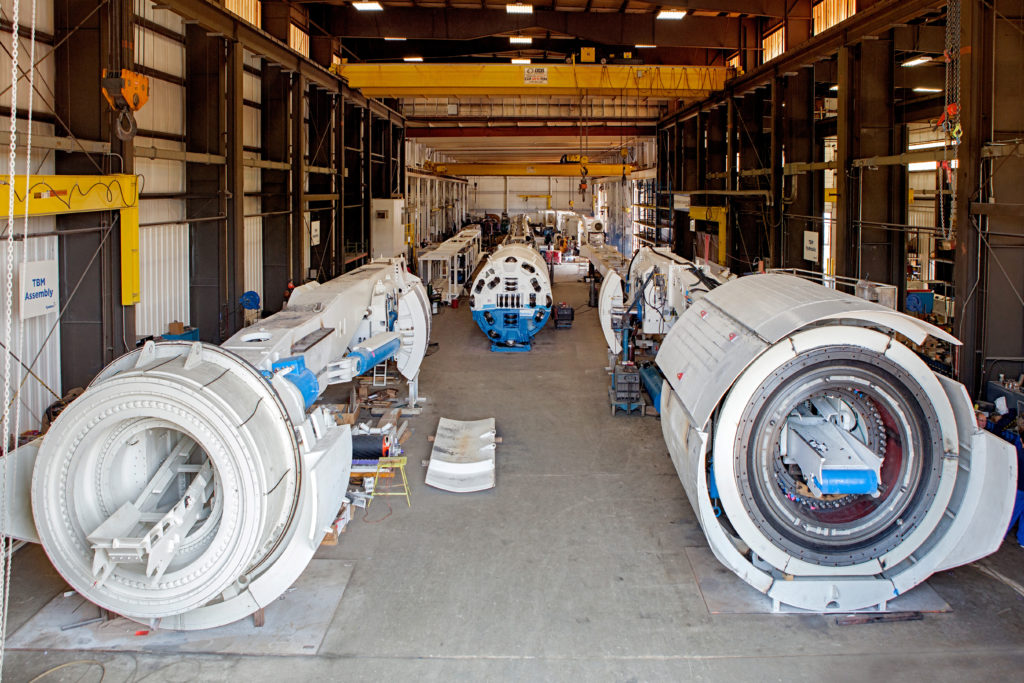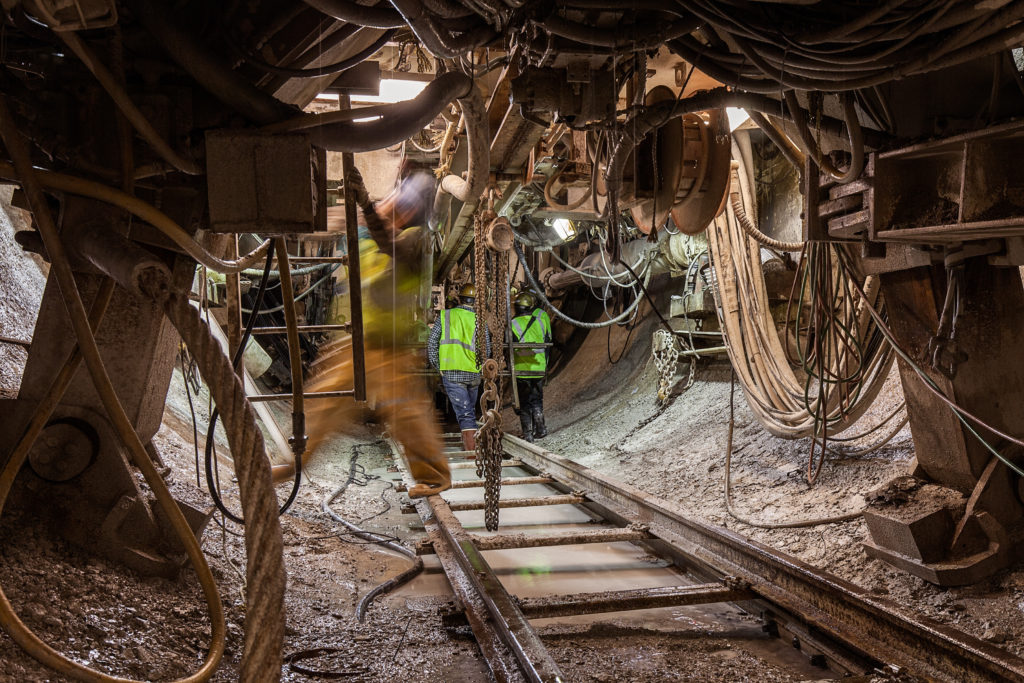Year: 2017
2017国际轨道交通技术展览会
Event Name: STUVA Expo and Conference
Dates: December 6-7, 2017
Location: Messe Stuttgart, Germany
Venue: Messe Stuttgart Trade Fair Centre
With an increasing rate of growth, STUVA-Expo will take place parallel to STUVA-Conference December 6-7 in Messe Stuttgart, Germany. The Robbins Company is looking forward to sharing information about current TBM projects operating world-wide at this ever-growing event.
罗宾斯盾构机斋浦尔标志性城门不足5米下掘进
大陆工程公司(Continental Engineering Corporation ,简称CEC)为斋浦尔地铁项目开挖的隧道临着世界范围内地铁项目通常面临的挑战,包括小场地,以及有关路段和淤泥储存空间等的相关问题。然而,这些挑战相对较简单。与隧道施工所面临的挑战相比。土压平衡盾构机(EPB)需要在极浅的埋深下掘进,以及在几个文化敏感的历史建筑旁边和下面掘进。在考虑隧道引起的地面沉降和振动的可能后果时,这些结构及其施工方法及材料的使用寿命非常令人关注。本文将介绍为确保这些历史建筑不受隧道施工的不利影响而采取的有关隧道掘进和地表监测的措施。
困难地质解决方案:新的掘进机解决方案为成功铺平了道路
在许多隧道掘进机驱动的隧道中,出现挤压地址、高涌水、大块石等挑战是一种现实的可能性。困难的地质解决方案(DGS)在提供准确的地面调查的同时,降低了承包商和业主在这些条件下的风险。这些方法如何付诸实践的故事涉及到在最近的一个项目上测试盾式硬岩隧道掘进机勇气的困难。从这些挑战中产生的是一种新的方法来处理岩石和混合地基中的预测和不可预见的地面条件。如双行程刀盘驱动、用于表面稳定的高压灌浆注入系统和涌水控制等DGS功能是可定制的,应视为内置在盾式硬岩隧道掘进机中。本文将介绍由现场经验提供的解决方案,在困难地区取得成功所需的工具,以及如何应用它们。
罗宾斯主梁式在极坚硬和不稳定岩石地质下为挪威水力发电项目开挖隧道
这台在2015年12月为Røssåga水力发电项目贯通隧道的掘进机,是20多年来第一个在挪威作业的隧道。在掘进中, 掘进机遇到了极坚硬的岩石地质,其强度高达280 兆。这样的地质对于掘进机和其刀具都是一个极端的挑战。在掘进中,更换了一个高效的主轴承也在隧道内完成。本文讨论了整个项目,包括掘进机设计、现场首次安装调试方案(OFTA)、所遇到的挑战及项目的成果。
翻新、翻修、再制造:设计一个世代相传的掘进机
 With the increase in large TBM projects over the last few decades and a global awareness of their environmental impacts, there has been a greater focus on the origin of TBMs and their parts. The focus has been further highlighted by the ITAtech; a technology-focused committee for the International Tunneling Association (ITA-AITES) that produced guidelines on rebuilds of machinery for mechanized tunnel excavation were released in 2015. While the guidelines are relatively new, Robbins has a long history of delivering robust machines, many of which are rebuilt (many are also 100% new). In this post, I’d like to explore just what a “rebuilt” TBM is, and what that means to Robbins as a TBM manufacturer.
With the increase in large TBM projects over the last few decades and a global awareness of their environmental impacts, there has been a greater focus on the origin of TBMs and their parts. The focus has been further highlighted by the ITAtech; a technology-focused committee for the International Tunneling Association (ITA-AITES) that produced guidelines on rebuilds of machinery for mechanized tunnel excavation were released in 2015. While the guidelines are relatively new, Robbins has a long history of delivering robust machines, many of which are rebuilt (many are also 100% new). In this post, I’d like to explore just what a “rebuilt” TBM is, and what that means to Robbins as a TBM manufacturer.
History and Terminology
Throughout Robbins’ history (over 65 years), our TBMs and design philosophies have been based on the understanding that TBMs require a substantial initial investment, and designing machines for single tunnels is neither economical nor sustainable. This realization has resulted in robust, sturdy designs of high quality that–even before the pencil is put to paper–are meant to last for multiple projects. This is clearly shown when you look at the number of Robbins TBMs around the world that are excavating their second, third, fourth or even their eighth or ninth tunnel. There are even Robbins TBMs manufactured in the 1960s that are still in operation!
For Robbins, the term “rebuilt” describes any manner of creating a custom TBM from already existing components. It is the term we use most and continue to use. The ITAtech guidelines introduce different terminologies depending on the extent to which a TBM is rebuilt. They are, very shortly, described here:
- Remanufacturing – Remanufacturing is a process with the aim to start a new life cycle of the product using its current or modified configuration.
- Refurbishment– Refurbishment can be considered a full maintenance, where defect parts are replaced to extend the life of the product in its original configuration or with small modifications.
The guidelines describe the requirements of each process in order to designate a TBM “refurbished” or a “remanufactured”, but in reality the majority of “rebuilt” TBMs may be somewhere in between these qualifications.
The Robbins Philosophy
Over the years Robbins has built a quality assurance system that ensures when we deliver a rebuilt machine, either to the original configuration or a modified one, we still adhere to a design life of 10,000 hours. This standard also includes checks to make sure that all the components are in a functional condition of ‘as new’ or ‘new’. Due to our long experience in rebuilding TBMs, we can offer in principal the same warranty on a rebuilt machine as a new machine.
The Robbins philosophy on this is that, in order to offer the same design life and same warranties on a rebuilt machine, the initial design of the TBM will need to consider that the TBM will be used on several projects. This means that the major structures will need to be strong enough to survive even the toughest conditions and that worn parts can easily be replaced. If the machine is not properly designed for multiple projects, there will be a need to do major work to get the TBM in a working condition either in its original or modified configuration. Robbins strongly believes that considering the total life cycle of a machine, even in its first design stages, is the most economical and sustainable option.
One can argue that project owners typically only have one project and that the condition of the TBM and the suitability of its rebuild is therefore not essential. This is something that is also reflected in many of today’s tunneling projects, where the commercial consideration is often given far more attention than the technical one. We would argue, however, that an initially sturdy and robust design of the TBM will give the project more uptime, higher production rates and better flexibility if unexpected conditions are encountered, making it a good and effective kind of insurance for the project. This effect has been clearly identified in the field, where Robbins has more than 90% of world production records in hard rock.

What’s Missing
In terms of the international guidelines, they are certainly necessary and welcomed. However, the strictness of the guidelines makes them hard to adopt worldwide and perhaps not realistic for the majority of TBM rebuilds, which are customized based on project needs. The ITAtech guideline is also missing something else: the definition of what makes a TBM “new”. While opinions from different suppliers vary, Robbins is perfectly clear on this topic: If you are buying a new TBM, then it is a 100% new TBM with only 100% new components. We strongly believe the whole industry should commit to this definition of what makes a TBM “new”, and this definition should be added to the guidelines.
Robbins has throughout the years built up a vast experience in providing the right machine for the right project, whether that means a new or rebuilt machine. As a part of this experience, we are convinced that the life cycle of TBMs should be considered at the earliest stages of the design process. Designing machines with ease of rebuilding in mind ensures that we do not have to start from scratch every time a machine needs work. It also results in time, cost, and energy savings when the time does come to rebuild a machine for a new project. For the industry, this type of perspective is the only economical and sustainable option going forward.
By Sindre Log, Civil Engineer and General Manager for Robbins Norway
小型远程遥控掘进机参数表
小型远程遥控掘进机(SBU-RC)是非开挖行业的一个革新,在小直径上使长度、线性和坡度敏感的交叉口成为可能。该SBU-RC是一个无人驾驶、铰链式,可在混合地质和硬岩中掘进,配合螺旋掘进机(ABM)或者顶管系统使用。
连续输送机的产品参数表
罗宾斯的连续推进式输送机旨在提高清除淤泥的效率,并大大简化隧道物流。罗宾斯连续输送机已成功应用于全球近100个项目,超过任何其他隧道式输送机制造商。
大直径20英寸滚刀:硬质岩石刀具寿命和性能的比较
优化在硬质岩石中掘进滚刀的使用寿命和穿透率是预测项目成功的重要指标之一。随着硬岩掘进机在越来越困难的条件和更长的隧道中使用,使用哪种类型滚刀的问题变得至关重要。在中国东北地区的一个这样的项目中,对9种不同直径8.5米的硬质岩石、各种制造商的主梁式掘进机进行了不同类型滚刀的钢材和尺寸的试验。掘进机在类似的花岗岩地质中挖掘了一条巨大的水隧道。
本文将以中国最新的实例为研究重点,对20英寸滚刀的发展和大直径刀具的情况进行研究。将讨论不同的推进速度、刀具寿命、工具钢材和挖掘岩石的挑战。本文最后给出了在坚硬岩石中长隧道掘进的掘进机中最佳刀具寿命的建议。
利用“指挥椅”模拟器技术优化现代掘进机性能
隧道掘进机的总体设计中,隧道掘进机的司机室和控制装置往往是优先考虑的问题。然而,它们的正确设计和包含最新技术意味着一个成功的项目和一个失败的项目之间的区别。
在用于软土复合地质机器上,行业通常让操作员控制对特定机器或控制系统几乎没有或根本没有实际经验的机器。在某些情况下,这种做法可能会导致重大事故,如人口稠密的城市地区的地面隆起或落水洞,造成重大破坏、停工以及无法估量的损害和成本。
本文将讨论掘进机操作员操作中的掘进和发展,以及“指挥椅”技术作为一种训练工具(以掘进机模拟器的形式)和现代掘进机控制方法的应用。
朗德西部分支旁道项目-掘进机在纽约哈德逊河下的高水压和高进水条件下在硬岩中掘进
本文介绍了一台单护盾硬岩隧道掘进机用于纽约州的高涌水和高水压的硬岩地质下掘进。为了克服困难条件,掘进机设计用于处理2500 gpm的进水量,并在30巴的压力下密封。掘进机将开挖一条隧道来替换特拉华州渡槽的一部分受损部分,该渡槽向纽约市供应一半的原水。2.5英里的绕行隧道穿过哈德逊河(Hudson River),地质结构由页岩和石灰石组成。
由于水压和进水量较高,掘进机设计有新的主轴承密封系统,如果遇到高涌水,则关闭掘进机。设备配备两个排水系统和多个钻孔和注浆系统,用于开挖前注浆和分段衬砌回填。针对本项目制定了系统的钻孔和注浆程序,并将其纳入掘进机和备用设计中,以确保设备能够处理本项目极其困难的地质条件下作业。
最近要闻
- Long Haul TBM: Use of a Rebuilt Main Beam Machine at the DigIndy Tunnel System in Indianapolis, IN
- Evaluating TBM Design and Performance, 30 Years Apart: The Lesotho Highlands Water Tunnel, Phase 1 and Phase 2
- Use of a Tunnel Boring Machine on Nepal’s First and Second TBM-Driven Tunnels
- Record-Setting Large Diameter Mixed Ground Tunneling in Turkey: The Eşme-Salihli Railway Tunnel
- Lessons Learned During Excavation of the Incredibly Challenging Yin Han Ji Wei Water Diversion Tunnel

 Close
Close  Menu
Menu 
